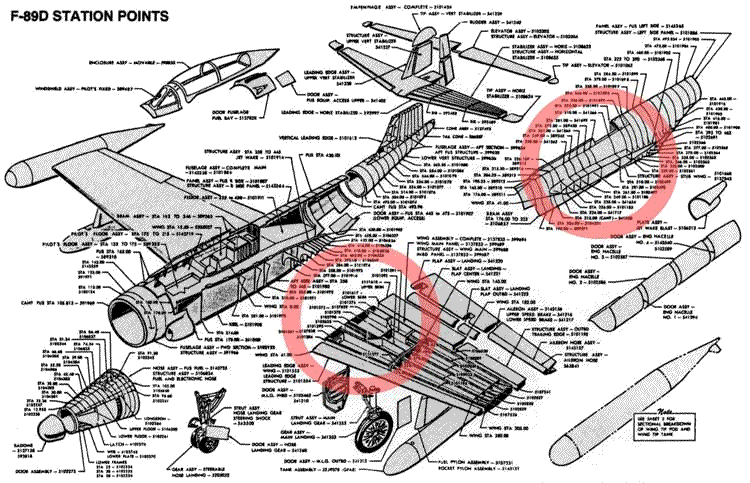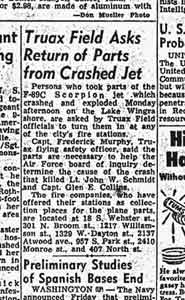
Structural details of F-89D Scorpion, which was generally similar to the F-89C. Circles indicate failure-prone wing root areas.
The Troubled F-89C
Development of the Northrop F-89 Scorpion was started in 1945, when air defense planners concluded that the increased speeds and altitudes of foreseeable enemy bombers required a long-range defensive jet interceptor equipped with all-weather radar, heavy cannon armament, and near sonic-speed performance at all altitudes.
The F-89 was the last airplane designed under the direction of company founder Jack Northrop. Though he lacked any formal engineering training, Northrop's contributions to aerodynamics and to the development of all-metal aircraft construction were legendary within the aviation industry. He had played a role in the design of the wings of the "Spirit of St. Louis" and the Douglas DC-3, among many other achievements, but with the transonic F-89, he and his engineers were moving into an entirely new realm of technical challenges. The F-89 (nicknamed "Scorpion" because of its upswept tail) was designed to be able to intercept Soviet piston-engined bombers in the class of the Tupolev Tu-4, a copy of the Boeing B-29. It was to be able to attack a target flying at 300-400 mph speeds at low to medium altitudes, day or night and under all weather conditions, using a radar system that was capable of guiding the aircraft to a target in such poor visibility that the pilot might not even be able to see his prey. When the proper position for firing was achieved, six 20mm cannon would be used to attack the target, making the F-89 the most powerfully-armed fighter of its time.
The F-89 was intended to reach speeds approaching Mach 1: about 650 mph depending on altitude. For aerodynamic reasons this necessitated a very thin, low-drag wing. At the same time, the need for long range and adequate takeoff performance with heavy fuel loads mandated a large wingspan. The resulting structure required the wing roots to withstand enormous loads during flight maneuvers.
The first prototype Scorpion took to the air in August 1948. Many shortcomings soon became evident. On February 22, 1950, an early prototype was lost during a demonstration flight when its horizontal stabilizer tore away.
Problems also surfaced with the engines, which produced less power than predicted, and with the complex radar system being developed by Hughes Aircraft. At several points during 1949 and 1950 the Air Force came close to canceling the F-89 due to its seemingly intractable problems, but by 1951, with the introduction of the F-89C, the first fully operational version of the plane, it seemed that the Scorpion was on the way to becoming a major addition to the Air Force's arsenal.
The F-89C made its first flight in September, 1951, and the first operational F-89C squadron was the 176th Fighter Interceptor Squadron at Truax AFB, Madison, Wisconsin, which received its first Scorpion on February 8, 1952.
* On February 25, an F-89C shed a wing and disintegrated in flight. After investigators determined that the aircraft had broken up due to overstressing by the pilot, speed and g-load limits were imposed.
* On June 18, just three days after the F-89C became operational with the 74th FIS at Presque Isle AFB, Maine, the wing of one of the squadron's new Scorpions cracked and folded in flight, killing the pilot and radar observer.
* On August 30, two F-89Cs of the 27th FIS were flying in an aerial display at the International Aviation Exhibition near Detroit. During a high-speed pass over the field, the left wing of one aircraft snapped off at the root. The fighter spun to destruction, killing both crewmen and spewing debris into the crowd, injuring five spectators.
* Despite even stricter speed and g-limits, another F-89C was lost to a wing failure on September 15th.
* On September 22, still another F-89C of the 74th FIS experienced an in-flight structural failure when its crew heard a loud bang and saw one of their wings fold up over their cockpit. Fortunately, both men managed to exit the plane and lived to tell the story.
The Air Force grounded all F-89s where they were. Air Defense Command was so enraged at the latest problems with the jinxed aircraft that it ordered Northrop to move the F-89s to modification centers using company test pilots and at company expense.
In November, Northrop began an intensive analysis and redesign effort on the F-89C's wing, a process which ultimately would cost taxpayers $17 million and take nine months to complete.
Northrop's engineers soon identified the problems that had combined to cripple the F-89C. The first issue was structural. In order to provide adequate strength for the aircraft's large, thin wing, while at the same time obtaining the lightest possible structure, they had used a promising new aluminum alloy, T75ST, in the highly-loaded fittings where the wing's root was bolted to the fuselage. T75ST had promised high strength with low weight. A drawback, however, was that the fatigue characteristics of the new alloy under extreme conditions were not fully understood. Northrop lacked facilities for testing structural specimens of the Scorpion's airframe to their full design limits, and it was decided that structural simulations of the airplane's wing could be tested to 60 percent of their limit loads and the remaining portion of the stress envelope could be extrapolated mathematically. What the designers did not realize, however, was that several factors inherent in the operation of high-speed jets had combined to make this a foolish choice.
In studying their wind tunnel data and the accident reports, Northrop's aerodynamicists realized that at high speeds and under high loads, the thin, springlike wing of the Scorpion could begin an extremely rapid twisting or fluttering motion -- a motion that would interact with the airflow over the wing in such a way that the flutter would actually increase -- a "diverging aeroelastic oscillation," in technical terms. This phenomenon could develop so quickly that it was hardly possible for a pilot to detect it and correct for it. Exacerbating this aerodynamic-structural interaction was another problem -- the new hydraulically-powered control system needed to steer the aircraft at high speeds had little "feel," or feedback, as did the sensitive cable-driven controls of earlier fighters. A pilot could unwittingly fly his plane into this deadly oscillation region with little warning.
The final piece of the puzzle was the T75 alloy in the machined wing root fittings. The new alloy turned out to have unexpectedly high "notch sensitivity," meaning that any manufacturing imperfections, scratches, or dents could become origins for fast-spreading fatigue cracks.
When the F-89C was placed in test rigs capable of duplicating the full loads experienced by actual aircraft in service, Nortrop's structural engineers were horrified to find that the wing root attachment fittings began failing catastrophically. Combined with aeroelastic stress, these structural issues made the F-89C a very dangerous airplane. Northrop engineers immediately redesigned the wing root, reenforced the wing structure, and replaced the T75 fittings with massively stronger forged steel units. Each F-89 in Air Force service was returned to Northrop for a complete rebuild on a new assembly line.
To learn more about the phenomenon of aeroelasticity, which would turn out to be a problem for a number of first-generation high-performance jet aircraft, refer to Texas A&M University's excellent Aeroelasticity Department site:
By the end of June, 1953, only thirty-six F-89Cs out of the original production run of 172 were back in service with Air Defense Command, and this number would remain virtually constant for the next year.
The 433d Fighter Interceptor Squadron replaced the 176th at Truax in November 1952. In an oblique reference to the embarrassing problems with the Scorpion, the Truax AFC commander assured the Madison newspapers that both of the F-89s lost on 23 November 1953 were "corrected models." The cause of the first accident is mysterious, but it's clear that the Air Force worried about more structural problems with the airplane. It urged the public to turn in any pieces of wreckage from the initial crash for analysis.
 |
Air Force investigators were desperate to recover every scrap of Schmidt's plane for accident analysis |
Ironically, the structural modifications to the F-89C helped make it one of the most reliable aircraft in the inventory. The twin losses in November 1953 were among the few that the airplane suffered in its short period of front-line Air Defense Command service. By 1954 it was replaced by the F-89D, which carried powerful air-to-air rocket armament and had improved performance, and the F-89Cs were turned over to Reserve units.